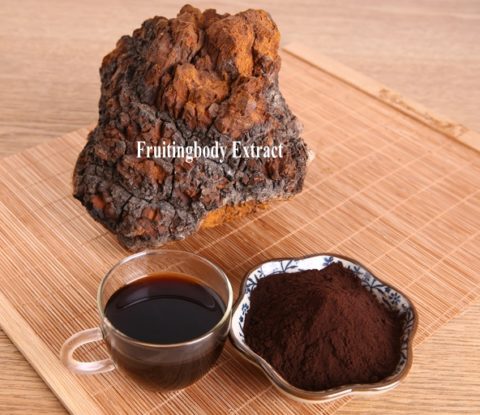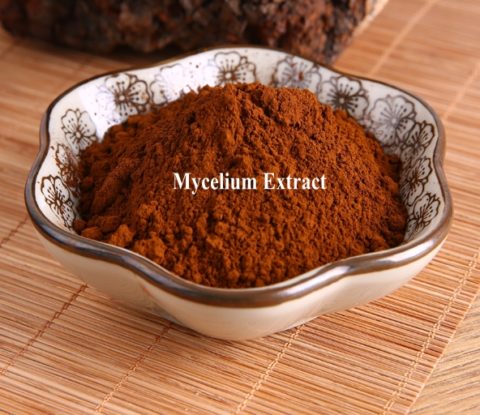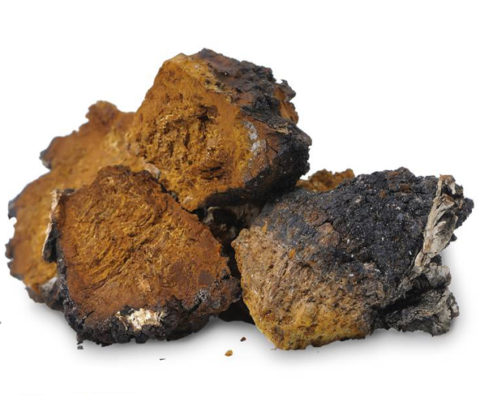
Chaga Extract Powder(Inonotus Obliquus) 10%,20%,30%,50% Polysacchrides UV
Chaga mushroom extract has indicated possible future potential in cancer therapy, as an antioxidant, in immunotherapy, and as an anti-inflammatory.
Chaga Mushroom Extract Powder(Inonotus Obliquus)
【Chinese Name】: Bai Hua Rong
【Latin Name】: Inonotus obliquus (Ach. ex Pers.) Pilat
【Derivation of name】: Obliquus means “slanted” or “oblique.”
【Synonyms】: Boletus obliquus Ach. ex Pers., Polyporus obliquus (Ach. ex Pers.) Fr.; Poria obliqua (Ach. ex Pers.) P. Karst
【Common names】: Clinker polypore, birch conk, birch
canker polypore, chaga, Inonotus obliquus; Phaeoporus obliquus; Fuscoporia obliquus
【Occurrence on wood substrate】: Parasitic; sterile conk made of compacted hyphae forming almost exclusively on trunks of living birch (Betula) species; conks found year-round
【Active ingredients】: Polysaccharides
【Specification】: Polysaccharides 10%,20%,30%,50%, 1-2% triterpenoid, 10:1, 20:1
【Test Method】: UV&HPLC&TLC
【Appearance】: Brownish fine powder
【Particle size】: 100% pass 80 mesh
【Main Function】: Stimulate Immune System
【Physicochemical index】:
Heavy Metal <10ppm(As <1ppm, Pb <2ppm, Hg <0.2ppm);
Pesticides Residues <1ppm;
Total Plate Count <1000cfu/g (Yeast & Mould <100cfu/g, Salmonella: Negative, E.Coli: Negative).
Brief introduction
Chaga extract is one of the most powerful phyto-medicines in the world. Inonotus obliquus, commonly known as chaga mushroom, is a fungus inHymenochaetaceae family. It is parasitic on birch and other trees. The sterile conk is irregularly formed and has the appearance of burnt charcoal. It is not the fruiting body of the fungus, but a mass of mycelium, mostly black due to the presence of massive amounts of melanin. The fertile fruiting body can be found very rarely as a resupinate (crustose) fungus on or near the clinker, usually appearing after the host tree is dead. Inonotus obliquus grows in birch forests of Russia, Korea, North-eastern China, Eastern and Northern Europe, northern areas of the United States, in the North Carolina mountains and in Canada.
Chaga has been used as a folk remedy in Russia and Siberia since the 16th century. According to the Memorial Sloan–Kettering Cancer Center, “no clinical trials have been conducted to assess chaga’s safety and efficacy for disease prevention or for the treatment of cancer, cardiovascular disease, or diabetes”. They caution that the mushroom extract can interact with other d-rugs.
Laboratory studies on extract of chaga mushroom extracthas indicated possible future potential in cancer therapy, as an antioxidant, in immunotherapy, and as an anti-inflammatory. Chemical analysis shows that chaga mushroom contains a range of secondary metabolites, including phenolic compounds such as melanins, and lanostane-type triterpenes, which include a small percentage of betulinic acid.
Composition Analysis of Chaga Mushroom
Raw Chaga mushroom’s composition include:
Water 13.2%
Proteins 2.40%
Lipids 2.40%
Ash 10.1%
Carbohydrates 71.9 % (lignin 32.6%; beta-glucans 12.0%)
Ergosterol 35.3 mg %
K 2.98%
Na 0.02%
Ca 0.06%
Mn ± 110 ppm
The total energy is 159.4 kcal/100 g
A synergy was first reported by Russian researchers in the 1950s, who found that the properties of chaga were enhanced if it was encased in a casket of birch bark. Chaga contains a certain amount of betulin and betulinic acid, which it metabolizes from the birch bark on which it grows. The white component of the birch bark contains an even greater amount of betulin—a waxy substance that protects the tree from water, insects, and so on. Both betulin and betulinic acid are very close in chemical structure to beneficial cholesterol and can serve as precursors to cholesterol in the human body, supporting cell membrane stabilization, healthy hormone production, and other vital functions.
Chaga extract has an ORAC score of a couple of hundred per gram. When you combine chaga with the betulin-rich birch bark, it comes out with an exceptional ORAC score—higher than 1,700 per gram. The efficacy of these constituents was first studied at the University of Chicago, where they evaluated the bark of birch logs that were being used in the school’s wood-burning furnace.
Researchers stripped the bark off, extracted the betulinic acid, and evaluated it in animal studies. They found that this substance destroyed melanoma cells in rats. This led the medicine companies to develop a semi-synthetic betulinic acid that has never really caught on in the marketplace. There have been a number of other studies of betulinic acid, and it has been found to be a very effective antitumor agent. Betulin and betulinic acid are highenergy plant sterols (a subgroup of steroids) that act as efficient scavengers of free radicals and also slice apart tumor cells. Researchers have found that these compounds also induce apoptosis (programmed cell death) of cancerous cells. Russian and Korean researchers have indicated that if chaga is ingested with a source of cholesterol, it becomes more bioavailable and therefore more effective. Similarly, birch bark consumed with a food high in cholesterol content, such as raw egg, has greater efficacy.
One of the key sterols found in chaga is lanosterol. This is another precursor to human cholesterol, and thus helps the body rebuild cell membranes and supports the endocrine system. Lanosterol also possesses antiviral properties. Another powerful component in chaga is the polysaccharide content, which supports immune function. Chaga contains high levels of 1,3 beta glucan, one of the most potent and healing polysaccharides known. Not only is beta glucan renowned for its role in activating the immune system, but it also reduces blood sugar in people who suffer abnormal blood sugar peaks. Chaga actually contains a vast array of substances that are of value in human nutrition.
Chaga Mushroom Extract Benefits
1. Antioxidant function
Chaga extract is known for its very high content of superoxide dismutase (SOD), an important enzyme that functions as a powerful antioxidant. SOD performs a vital antiaging function by neutralizing oxygen free radicals, preventing oxidative damage to cells and tissues. In studies, low tissue levels of SOD have been associated with both a decline in overall health and a reduction in life span.
SOD occurs naturally in different forms in all human tissues, but levels decline with age, particularly after age 30. The best way to increase SOD levels in the body is with food, since dietary supplements that contain the enzyme may be difficult to absorb. Good sources of SOD include chaga and other medicinal mushrooms, as well as peas, dark leafy greens, nutritional yeast, wheat grass, wheat germ, beef heart, and raw liver. Although nearly all medicinal mushrooms are rich in SOD, chaga has the highest concentration by far. It is 50 times higher in this potent enzyme than reishi. Chaga provides SOD in a form that can be utilized both topically and internally.
SOD has been studied in approximately 900 clinical trials, and the health benefits from its use have been clearly shown. For example, cancer patients undergoing radiation who were given SOD in a form that they could absorb had dramatically better survival, with less toxicity, less scarring, and better wound healing. We believe we don’t always have to study everything by conducting research costing thousands (or millions) of dollars. We can look at the existing SOD studies and extrapolate chaga’s usefulness from them. Chaga is one of the highest sources of SOD known, and, therefore, people are likely to gain some similar benefit from taking it. Plus, this is naturally produced SOD, the divinely synthesized kind, with a biological power unmatched in any other form.
2. Immunity enhancement
Research has found that chaga extract has the capacity to stimulate the immune response while simultaneously lowering inflammation. Typically, medications have one effect or the other, but not both. This ability to normalize function qualifies chaga as an “adaptogen”, a substance that can either increase or decrease activity in the body as needed, to balance and restore appropriate functionality. Studies on immune function from Canada, Korea, and Japan have reported that chaga:
• Provides as many as seven antioxidant compounds
• Stimulates chemical messengers such as interleukins and tumor necrosis factor alpha
• Increases levels of infection-fighting cells such as macrophages
• Reduces excessive levels of inflammation and inhibits the inflammatory cascade
• Lowers levels of antibodies associated with intense allergic reactions (IgE)
• Prevents the breakdown of cell walls
• Inhibits the Epstein-Barr virus (in test tube research)
• Improves the immune profile in inflammatory colitis (in an animal study)
3). Anti-cancer effect
Inonotusobliquus (Chaga mushroom) belonging to Aphyllophoromycetodeae, one of the widely known medicinal mushrooms, has been used to treat various cancers in Russia and most of Baltic countries for many centuries. Hot-water and ethanol extract of I. obliquus has ability to induce apoptosis in human colon cancer (DLD-1) cells by prevention of reactive oxygen species (ROS)-induced tissue damage. Youn et al. (2009) examined the anti-proliferative effects of water extract of I. obliquus extract on murine melanoma (B16-F10) cells(Potential anticancer properties of the water extract of Inonotus [corrected] obliquus by induction of apoptosis in melanoma B16-F10 cells. Youn MJ, Kim JK, Park SY, Kim Y, Park C, Kim ES, Park KI, So HS, Park R J Ethnopharmacol. 2009 Jan 21; 121(2):221-8.).
The chaga extract not only inhibited the growth of B16-F10 cells by arresting cell cycle at G0/G1 phase and causing apoptosis, but also induced cell differentiation. These effects were associated with the down-regulation of pRb, p53 and p27 expression levels, and further showed that I. obliquus extract resulted in a G0/G1 cell cycle arrest with reduction of cyclin E/D1 and Cdk 2/4 expression levels. Furthermore, the anti-tumor effect of I. obliquus extract was assessed in vivo in Balb/c mice. Intraperitoneal administration of I. obliquus extract significantly inhibited the growth of tumor mass in B16-F10 cells implanted mice, resulting in a 3-fold inhibition at dose of 20 mg/kg/day for 10 days. The ethanolic extract of sclerotium and fruiting body of I. obliquus elicited significant anti-tumor activity, 74.6 and 44.2%, respectively(In vitro antitumor activity and structure characterization of ethanol extracts from wild and cultivated Chaga medicinal mushroom, Inonotus obliquus (Pers.:Fr.) Pilát (Aphyllophoromycetideae). Sun Y, Yin T, Chen XH, Zhang G, Curtis RB, Lu ZH, Jiang JH, Int J Med Mushrooms. 2011; 13(2):121-30.).
Researches on Chaga Mushroom
1. In 1960, the U.S. National Cancer Institute noted a report that a decoction of Chaga had been used successfully to treat cancer in Australia. Well known for stimulating the immune system, Chaga was approved for public use against cancer by the Medical Academy of Science in Moscow in 1955.2. John Pezzuto of the University of Chicago is quoted as “the activity of the Betulinic acid is one of the most promising discoveries amongst 2500 plant extracts studied.” The Betulinic acid contained in Chaga covers the full spectrum of immune stimulating effects found in similar medicinal mushrooms such as Maitake and Shiitake mushrooms.
3. Russian and Japanese medical professionals both contend Chaga is many times more effective than Ganoderma Lucidum or Phellinus Linteus. The International Agriculture Development Institute in Korea confirms such claims.
4. The Japanese Cancer Society claims Chaga plays an important role in combating cancer and it jointly used with pharmacology drugs and chemotherapy diminishes their side effects.
5. “It is a fact that Chaga, placed into a birch bark casket, acquires more expressed therapeutic properties. Bioactive substances of the white part of birch bark having triterpenic bonds – betulin, lupeol, betulinic acid, etc. – possess anti-cancerous activity, causing apoptosis (programmed cell death) of cancerous cells and this is transfered to Chaga, thus strengthening its properties..”, says Galina Mikhaylovna Fedoseeva the Chairman of the Department of Pharmacognosy and Botany of Irkutsk State Medical University, professor, Doctor of the pharmaceutical sciences.
6. Numerous studies also indicate a 50% reduction in glycemic peaks are achieved due to the Beta Glucan effects on blood sugar levels. There are over 1000 research papers on Beta Glucan activity including studies from Harvard Medical School, National Cancer Institute, the Department of Agriculture and others. These studies prove Beta Glucan are external immunomodulators to keep one’s immune system in a highly prepared state.






